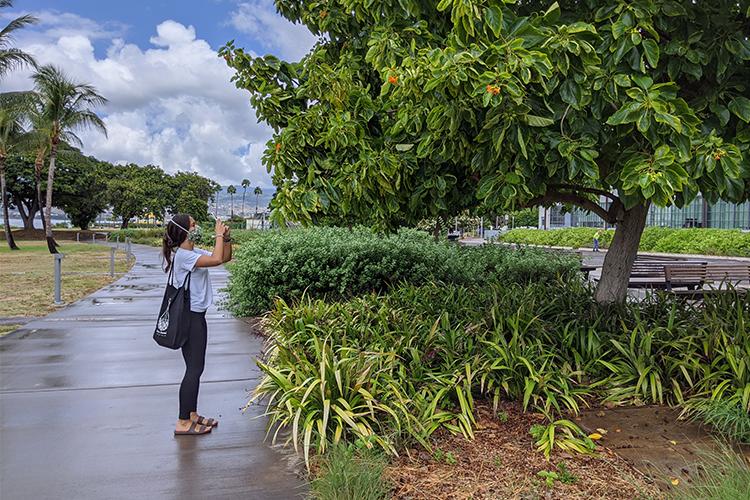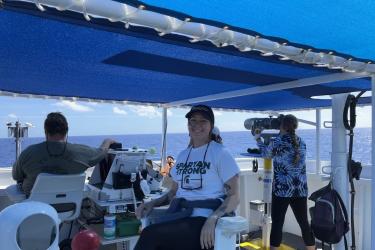Aloha! My name is Tehani Malterre, and I participated in the NOAA Hollings Preparation Program with the NOAA Fisheries Pacific Islands Regional Office (PIRO) during the summer of 2020. Over the course of my 6-week internship, I created an interactive virtual reality tool to help perpetuate NOAAʻs mission of sharing knowledge and education with others.
Creating a Sense of Place Using Virtual Reality
Iʻve always had a passion for nature, the environment, and Hawaiian culture. My internship with PIRO allowed me to explore these interests through my project.
During my time at NOAA, I created a virtual reality tour of the NOAA Inouye Regional Center (IRC) exterior, the headquarters of many of the NOAA operations in Hawaiʻi and the Pacific. The IRC Is located on Mokuʻumeʻume (Ford Island), within Pu‘uloa (Pearl Harbor), O‘ahu. Through the tour, I sought to create a sense of place and educate students about the area surrounding the IRC. To do this, I incorporated aspects of land-based history, Hawaiian cultural knowledge, NOAA operations, and Hawaiian language.
I began my project by researching the history of Mokuʻumeʻume and the surrounding ahupuaʻa (traditional land division) of the ʻEwa moku (district) of Oʻahu. I also researched the facility itself and the campus’ different outdoor features, including the native plant garden and the Hawaiian star compass located in the back of the IRC. After compiling my findings from a variety of online and hardcopy sources, I visited the IRC to collect 360-degree images for the virtual reality tour.
One of the most valuable skills that I gained from my time in the Hollings Prep Program was how to use various technological tools. Under the guidance of my mentor at PIRO, for example, I learned how to use a 360 camera to capture images for the tour. I learned how to then compile those images, along with my research findings, into Adobe Captivate, a tour creation program. To enrich the experience for students, I embedded various audio files, images, and ahupuaʻa maps throughout the tour. Learning about these tools has opened my eyes to the vast capabilities of these types of technologies.
While working on this project, I loved being able to learn about and incorporate aspects of Hawaiian language and culture. I learned a lot about the ʻEwa moku, and Iʻm glad that my tour will help to perpetuate this knowledge. With the help of fluent Hawaiian language speakers, I was also able to practice my Hawaiian language skills by creating an identical version of the tour translated in Hawaiian. Having two versions allows users to choose whether they want to virtually tour the IRC grounds in English or Hawaiian.
Upon completing my project, I presented it to the NOAA Pacific Region Outreach Group and at the NOAA IRC Intern Symposium, where I received useful feedback from NOAA staff and other interns. This was my first time presenting at a symposium and, in doing so, I gained valuable skills and experience in composing a presentation and public speaking.
Enriching Our Intern Experience
This year, our Hollings Preparation Program (HPP) cohort was composed of 12 interns working with a variety of NOAA offices out of Hawaiʻi, California, and Washington. In addition to working on our individual projects over the course of the program, we were invited to attend a plethora of HPP webinars and online meetings that enriched our experience as interns.
Each week, NOAA staff organized online activities in which we learned about graduate school, the Ernest F. Hollings Program, and the many functions and branches within NOAA, among other topics. Staff also provided us optional educational opportunities, including a weekly book club and supplemental coffee hours.
When I first began my HPP internship, I was pleasantly surprised by the many educational and networking opportunities that were available to us through these webinars and meetings. This aspect of the program was truly invaluable and provided me with information, skills, and connections that will serve as essential tools in pursuing my educational and career goals for years to come.
HPP was an amazing summer experience that allowed me to explore my interests in NOAA’s work, environmental issues, and Hawaiian culture and history, while also cultivating essential skills in professionalism, technology, and personal growth. I hope that you can learn something new through my virtual tour of the NOAA IRC, just as I did along this personal journey of research and growth.
Meet the Blogger
Tehani participated as a summer 2020 intern for the Hollings Preparation Program with PIRO. She graduated from Kamehameha Schools Kapālama in 2019 and is currently pursuing a Bachelor of Science degree in Global Environmental Science at the University of Hawaiʻi at Mānoa. She hopes to be able to apply her degree in the fields of conservation, restoration, and ecology here in Hawaiʻi after completing her education.







